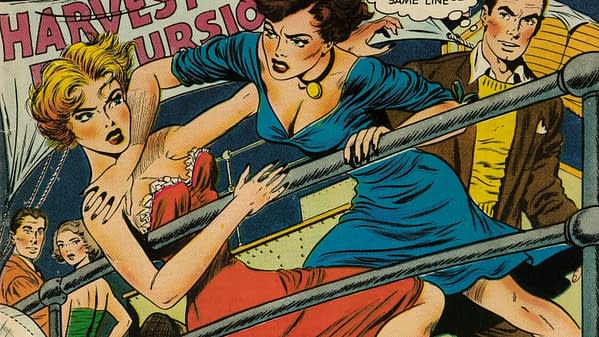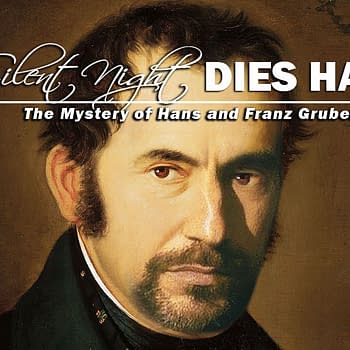Posted in: Comics, Heritage Sponsored, Vintage Paper | Tagged:
Fighting for Love on the Cover of Romantic Hearts #9, Up for Auction
Editor William K. Friedman was determined to test the limits in the wake of the 1954 Senate Hearings on comics, and Romantic Hearts #9 is an example.
Article Summary
- Romantic Hearts #9 showcases pre-Comics Code romance comics' boldness.
- Editor William K. Friedman intentionally challenged moral panic critics.
- Friedman's legal background includes defending publishers from censorship.
- Romantic Hearts #9 is an unusual example of 1950s comic book romance.
Master Publications and its related companies are best remembered by history for their Pre-Code Horror output, but Romantic Hearts #9 helps cement their place in romance comic book history as well. As historian Michelle Nolan puts it in her indispensable Love On the Racks: A History of American Romance Comics, "Perhaps no better example exists than Romantic Hearts #9 of what some romance comics had become in the days before the Comics Code Authority imposed self-censorship on the industry."

"The classic cat fight cover on Romantic Hearts #9 — one of the few in the history of romance comics — represented an apparently unintentional parody of pretty much everything the Fredric Wertham-inspired critics would have abhorred, though the issue appeared well after the psychiatrist's anti-comics screed, Seduction of the Innocent, hit bookstores earlier in 1954," Nolan also noted. "There were, of course, numerous passive-aggressive conflicts and tears on the covers of old romance comics, but this was something different — one of the wildest, weirdest covers ever slapped on a comic book that purported to deal with real life."
I'll disagree with Nolan on just one point here — I think Master Publications editor William K. Friedman was very intentional about making this cover exactly what the moral panic critics claimed to abhor. Writing about Pre-Code Horror issue Dark Mysteries #19, which was also edited by Friendman and hit stands not long before Romantic Hearts #9, I noted that "It almost seems like the editor of Dark Mysteries was purposefully testing the boundaries at this point — and I think this just might have been what was happening. Because Dark Mysteries publisher Master Publications had an editor who had made a career of helping publishers test limits."
Romantic Hearts #9 and Dark Mysteries #19, hit the newsstands in mid- to late-1954. Master Publications editor, William K. Friedman, also the owner of publisher Story Comics among others, testified in front of a U.S. Senate Subcommittee on Juvenile Delinquency earlier that year, with these issues perhaps in the planning stages or production shortly after he gave his testimony.
As Friedman's comfortable sparring in that testimony implies, this was not his first brush with defending publishers against government censorship. He was also a lawyer, and In 1934 he took on New York City over Commissioner of Licenses Paul Moss's actions in ordering 59 magazines off the newsstands there, including a number of pulps. Among other pulp publishers, Friedman represented Harry Donenfeld, who would soon become the publisher of DC Comics but was then the publisher of pulps including Pep Stories, Spicy Stories, and Gay Parisienne.
Friedman was known to be extremely hands-on as an editor, so the fact that the likes of Romantic Hearts #9 and Dark Mysteries #19 contained so many elements that Wertham and the Senate frowned upon was probably no accident. Friedman was familiar with the perceived boundaries and was willing to test them. And that's likely why, as Michelle Nolan again notes, "Romantic Hearts was a good example of the type of book the Comics Code Authority wanted to censor, or preferably eliminate."
CGC FN- 5.5 copyAnd eliminate them they did, just a few weeks later. A unique artifact of the pre-Code romance era, there's a Romantic Hearts #9 (Story Comics, 1954) up for auction in 2024 October 3 – 5 Good Girl Art and Romance Comics Showcase Auction #40269.

















